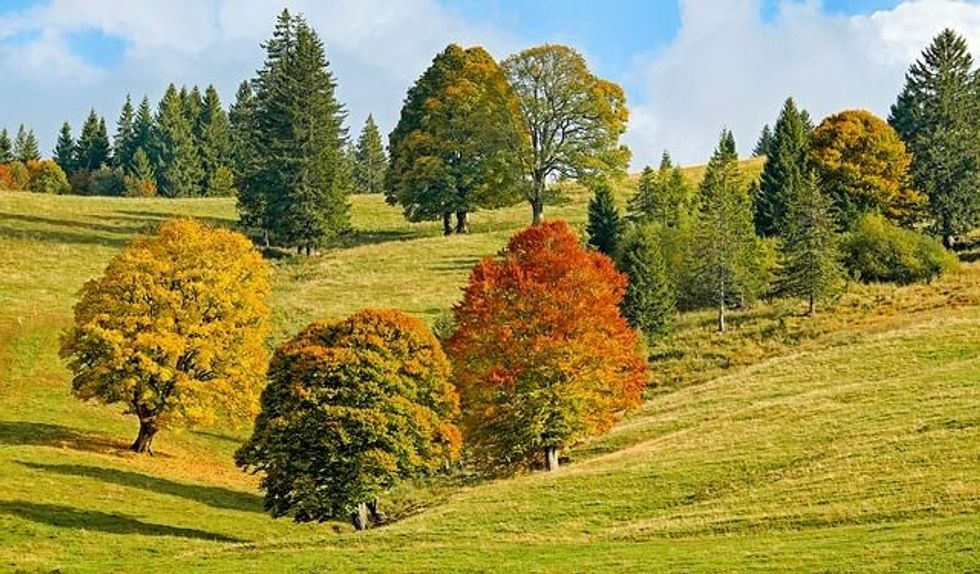Temperate forests or temperate deciduous forests are other names for deciduous forests.
The word 'deciduous' is used in horticulture and botany to describe trees and shrubs that shed leaves annually, generally in the autumn. It is the product of natural processes in plants.
Although they are two separate biomes, tropical and subtropical wet broadleaf forests are commonly referred to as jungles or rainforests. Tall trees in rainforests form a dense canopy that prevents light from reaching the forest floor.
Climate Of Deciduous Forests
Spring, summer, autumn, and winters are the four different seasons of the deciduous forest or temperate forests.
In the spring, the deciduous forest produces a lot of grass and leaves on trees to replace those that fell throughout the winter.
Because the trees provide shade in the summer, it is not as hot as it is in typical deciduous woods. July is the warmest month in the deciduous forest, with temperatures ranging from 35.6-100.4 F (2-38 C).
It may rain up to approximately 16 in (40.6 cm) or more in the summer since it rains most of the year. December temperatures may range from 10 F (-12.2 C) to at least 33.8 F (1 C). It does not rain about as much in the winter as it does in the summer.
The temperature in the winter is below freezing, although the average temperature is 50 F (10 C).
Temperature and humidity levels may fluctuate dramatically within a day, an hour, or even a few minutes. It's impossible to anticipate the weather all of the time.
Animal Life & Plant Life In Deciduous Forests
Deciduous forest biome: Temperate deciduous forests get 30-60 in (76.2-152.4 cm) of rain each year, making them the second-rainiest biome after the rainforest.
The color of their leaves changes with the seasons and finally falls to the ground in the winter.
The soil is incredibly fertile and rich in nutrients since there are deciduous trees and hardwood trees here.
Shrubs are typically found near clearings or forest edges, where there is more light.
The sap of various trees in the temperate deciduous forest is used to protect its roots from freezing during the winter.
Because some insects in the temperate deciduous biome are unable to withstand the winter, they lay eggs before dying.
The temperate deciduous forest biome houses common inhabitants such as black bears, wolves, and coyotes.
Types Of Deciduous Forests
Deciduous forests are those in which the majority of the trees shed their leaves after the regular growing season. These forests may be found in a variety of locations across the globe and have unique ecosystems, understory development, and soil dynamics. Two main varieties of deciduous forests exist all over the globe:
The first variety is temperate deciduous forest and these biomes are plant communities found in North and South America, Asia, the southern Himalayan foothills, Europe, and Oceania for agriculture.
They arose in climates with high seasonal temperature variations, with growth happening during hot summers, leaf drops in fall, and hibernation occurring during cold weather.
These seasonally unique communities feature a varied range of living forms that are heavily influenced by their climate's seasonality, particularly temperature and precipitation rates.
In various places, these varied and regionally variable ecological circumstances create unique forest plant groups.
The second variety is tropical and subtropical deciduous forest and these biomes have evolved in response to seasonal rainfall patterns, rather than seasonal temperature fluctuations.
During lengthy periods of drought, the foliage drops to preserve water and avoid thirst death.
Leaf drop is not seasonal, as it is in temperate regions, and may happen at any time of year and in different parts of the planet.
There may be differences in the time and length of leaf drops even within small tropical regions; opposite sides of the same mountain, locations with high water tables, or areas along streams and rivers can form a patchwork of leafy and leafless trees.
Characteristics Of Deciduous Forests
Here are some temperate deciduous forest facts and characteristics:
Maple, beech, and oak are some of the prevalent trees found in temperate deciduous forests.
Forests in temperate zones have neither too hot summers nor too cold winters.
The eastern region of North America has the world's biggest temperate deciduous forest, which was almost fully deforested for agricultural reasons by 1850.
Based on the height of the trees, temperate deciduous forests are divided into five zones; the tree stratum zone, small tree and sapling zone, shrub zone, herb zone, and ground zone are listed in order of height, from highest to lowest.
Aside from the eastern half of North America, the Near East, Europe, South America, and East Asia have the biggest regions of temperate deciduous forest.
Dry broadleaf forests and wet broadleaf forests are both common in tropical and subtropical deciduous forests. Drier climates to the north and south of the wet broadleaf woods are home to the dry broadleaf forests.
In tropical and subtropical deciduous forests, leaves fall in the dry season and regenerate in the rainy season. During the dry season, plants preserve water by dropping leaves.
Burning, deforestation, and overgrazing are all dangerous to dry broadleaf forests.
In dry broadleaf forests, the maximum plants and animals can be found in southern Mexico and central South America's Bolivian lowlands.
FAQs
What is the deciduous forest known for?
Deciduous forests are known for their shedding trees.
What makes a deciduous forest unique?
Their autumn-shedding plants make them unique.
How do animals survive in a deciduous forest?
Various animals found in the deciduous forest survive by adopting various methods of adaptation like hibernation, etc.
Do deciduous trees lose their leaves?
Yes, deciduous trees do indeed shed their leaves.
Where do deciduous forests grow?
A moderate environment with a winter season and year-round precipitation characterize deciduous forests, which may be found in three middle-latitude zones.









